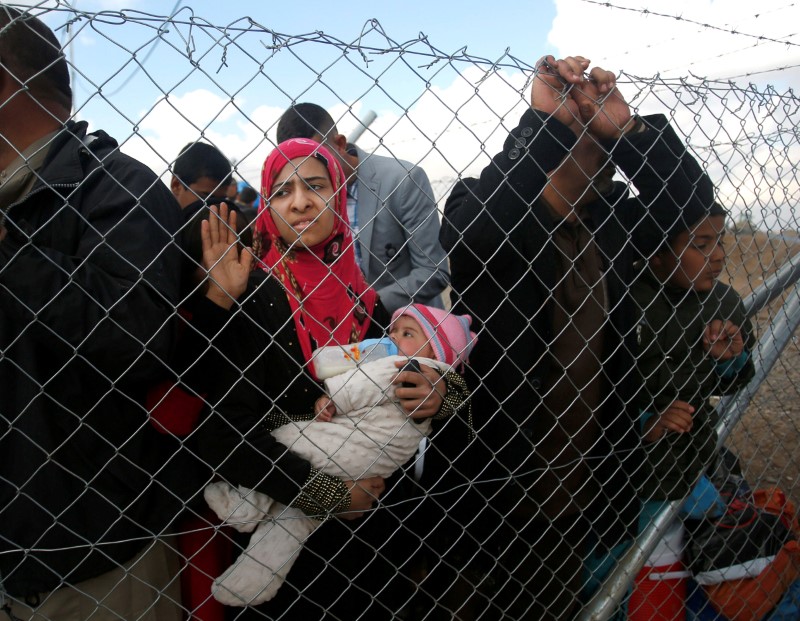
By Angus McDowall
BEIRUT (Reuters) – Syrian state media said on Monday that U.S.-led coalition aircraft had bombed a Syrian army position near the Iraqi border, causing deaths and injuries, but the U.S. military denied it was responsible.
The attack took place in al-Harra, southeast of the town of Albu Kamal, state news agency SANA said, citing a military source. SANA said the attack caused an unspecified number of deaths and injuries.
A commander in the alliance fighting alongside Damascus told Reuters that drones that were “probably American” had bombed the positions of Iraqi factions between Albu Kamal and Tanf, as well as Syrian military positions.
The commander, who is not Syrian and spoke on condition of anonymity, said the strike had killed and injured some Iraqi fighters but he did not give any numbers.
Iraq’s Popular Mobilisation Forces, a grouping of mostly Iran-backed Shi’ite paramilitaries, said a U.S. air strike on the Iraqi border with Syria killed 22 of its members and wounded 12 others.
“At 22:00 last night a U.S. plane hit a fixed headquarters of the Popular Mobilisation Forces’ 45th and 46th brigades defending the border strip with Syria using two guided missiles which led to the martyrdom of 22 fighters,” it said in a statement.
It demanded an explanation from the United States.
“No member of the U.S.-led coalition carried out strikes near Albu Kamal,” Major Josh Jacques, a U.S. Central Command spokesman, told Reuters.
The U.S.-led coalition uses air power and special forces to back an alliance of Syrian Arab and Kurdish militia fighting Islamic State northeast of Albu Kamal. U.S. forces also are based around the Tanf crossing, southwest of the town in the Syrian desert near the borders of Iraq and Jordan.
President Bashar al-Assad’s army, with the help of Iran-backed militias including Hezbollah and Iraqi groups, drove Islamic State from Albu Kamal and its environs last year but the jihadists have since staged attacks there.
The Popular Mobilisation Forces have been officially included in Iraq’s governmental forces but many of them still maintain loyalties to their former leaders and political groups. They said the base that was hit was 700 meters into Syrian territory and the Syrian government was aware of their presence.
A U.S. official, speaking on the condition of anonymity, said the U.S. military was concerned that Popular Mobilisation Forces could retaliate against American forces in Iraq. The official said the Pentagon was going out of its way to publicly make clear that it was not involved in the strike in order to minimize the risk of retaliation.
The United States acknowledges that it has about 5,200 troops in Iraq that are part of a coalition fighting Islamic State militants.
“OCCUPYING FORCES”
The Syrian Observatory for Human Rights, a war monitor, said unidentified planes had struck Lebanon’s Shi’ite Hezbollah and other allied foreign militias around Albu Kamal.
The UK-based Observatory said the strikes had killed 52 people. Reuters could not independently verify the Observatory’s report of casualties.
Asked about the reported air strikes, an Israeli military spokeswoman said: “We do not comment on foreign reports.”
Throughout Syria’s seven-year war, Israel has carried out scores of strikes within the neighboring country against what it describes as Hezbollah or Iranian targets.
Israel, alarmed about the clout of arch enemies Iran and Hezbollah, has pressed Russia, Assad’s other key ally, to make sure Tehran does not entrench its military sway in Syria.
Prime Minister Benjamin Netanyahu told his cabinet he had “repeated and clarified” his Syria policy in weekend phone calls with Russian President Vladimir Putin and U.S. Secretary of State Mike Pompeo.
“First of all, Iran must clear out of all of Syria,” Netanyahu said on Sunday, according to a statement from his office. “Secondly, we will take action, and are already taking action, against the attempted military entrenchment of Iran and its proxies, both close to the border and deep within Syria.”
In an interview last week, Assad called Hezbollah “a basic element” in the war and said “the need for these military forces will continue for a long time”.
He said the United States was an occupying power in Syria and that his state supported “any act of resistance, whether against terrorists or against occupying forces, regardless of their nationality.”
(Reporting By Laila Bassam, Angus McDowall, Ellen Francis and Lisa Barrington in Beirut; Additional reporting by Idrees Ali in Washington, Dan Williams in Jerusalem, Ulf Laessing and Ahmed Aboulenein in Baghdad; Editing by William Maclean and Bill Trott)







